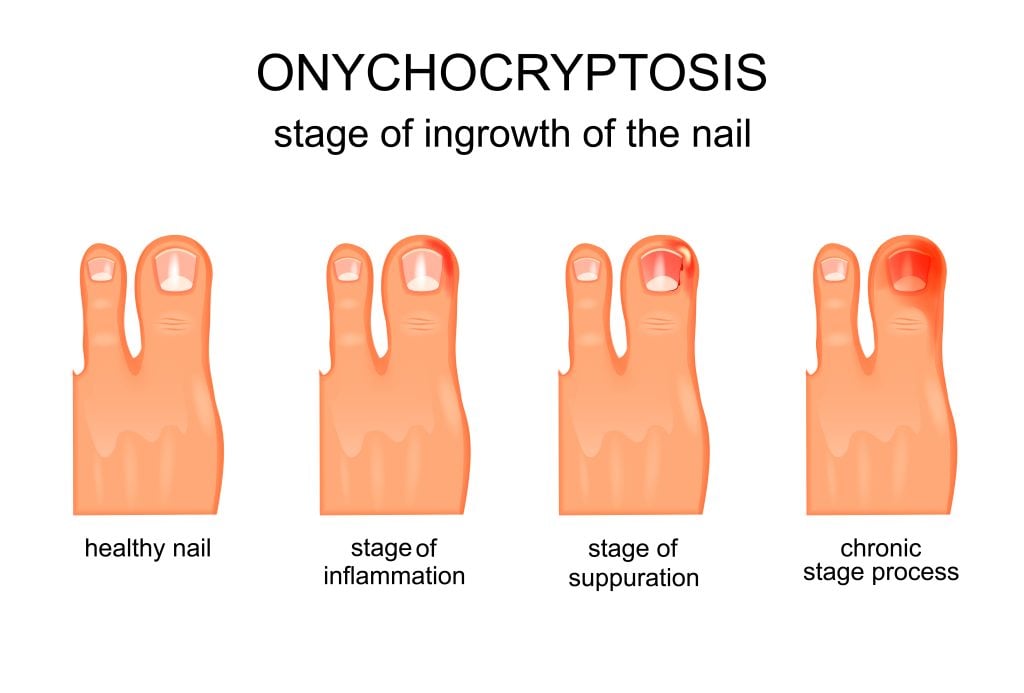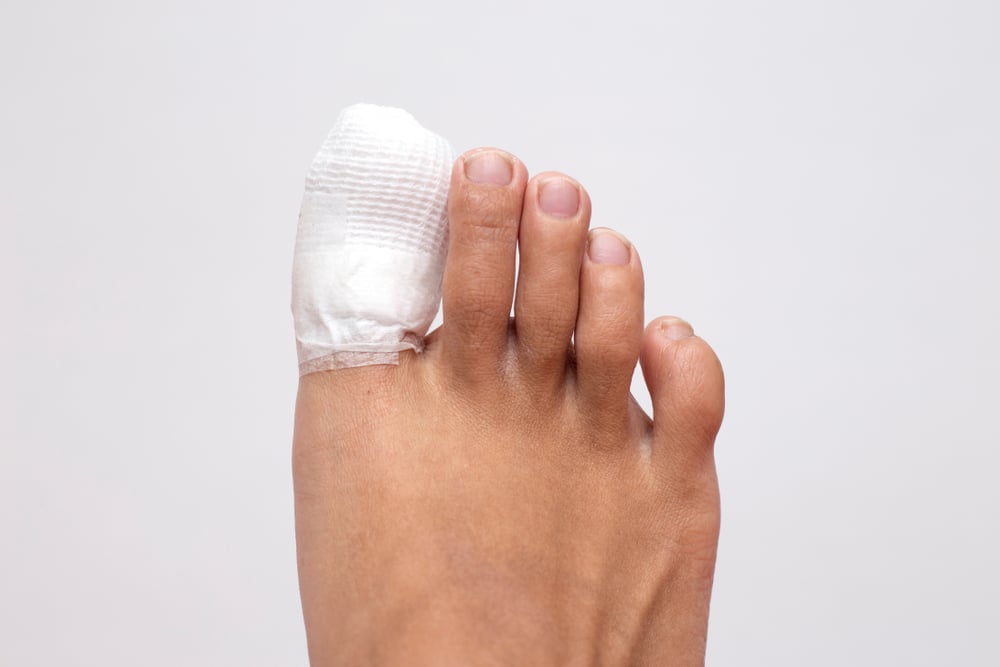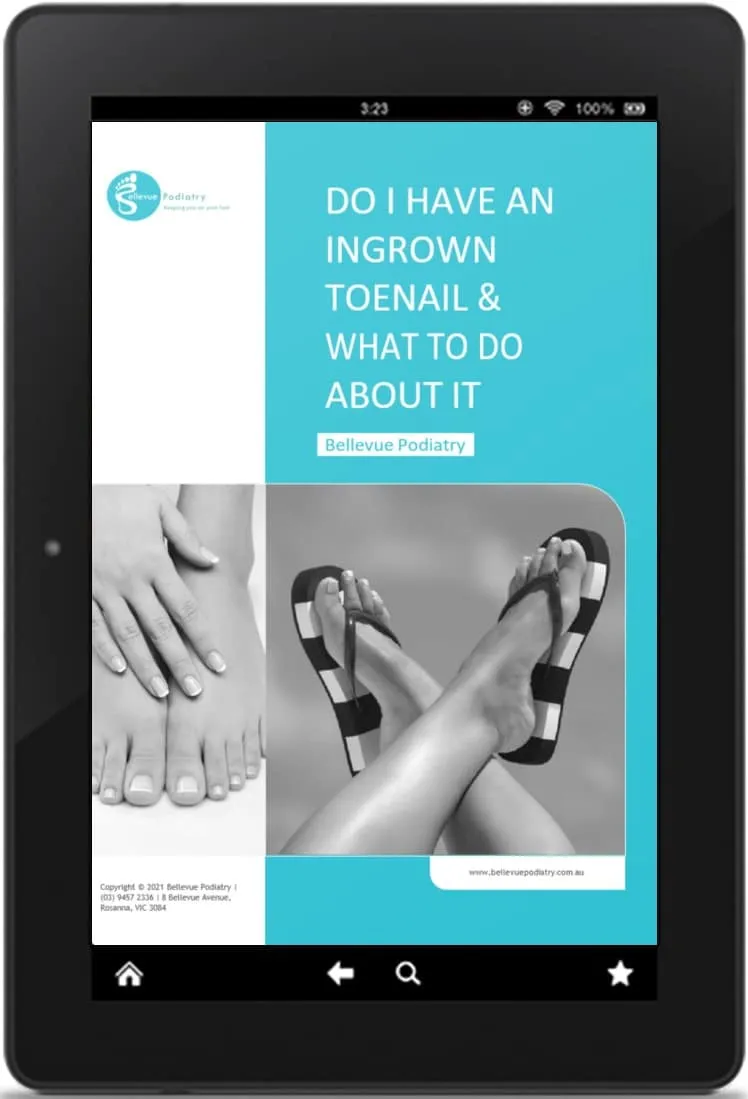You need relief fast when you’re suffering from a painful ingrown toenail (also known as onychocryptosis). Podiatrists offer a range of treatments, from simple home remedies to advanced surgical techniques.
We will start with conservative methods like proper nail trimming and padding, but if your ingrown nail persists, specialised devices or even surgery may be necessary.
So, what exactly can a podiatrist do to fix your ingrown toenail and get you back on your feet pain-free?
Key Takeaways
- Podiatrists trim and debride the ingrown toenails to alleviate pain and prevent further growth into the skin.
- For relief, podiatrists may place cotton or dental floss under the ingrown nail edge.
- Specialised devices, like BS Brace and Onyfix, used by podiatrists, promote healing without surgery while preserving the natural nail size.
- Podiatrists may recommend partial nail avulsion or complete nail removal surgery for severe or recurring ingrown toenails.
- Podiatrists guide patients on proper nail trimming techniques, foot hygiene, and appropriate footwear to prevent ingrown toenails.
Understanding Ingrown Toenails: Causes and Symptoms

Ingrown toenails, a common foot condition, occur when the corner or side of the toenail grows into the surrounding skin, leading to pain, discomfort, and inflammation:
- Common causes include improper nail trimming, ill-fitting shoes, toe trauma, and genetic predisposition to abnormal nail shapes.
- Symptoms often involve redness, swelling, and tenderness around the affected toenail, sometimes with pus, indicating potential infection.
- Untreated ingrown toenails can lead to chronic pain, infection spread, abscess formation, and impaired quality of life.
Proper foot hygiene and nail care practices help prevent ingrown toenails. Podiatrists employ various conservative and surgical treatment approaches to alleviate symptoms and prevent recurrence.
If you’re experiencing persistent ingrown toenail pain or signs of infection, it’s essential to seek prompt treatment from a qualified podiatrist.
Conservative Treatments: Home Remedies and Medical Advice

Even though they can be painful, mild ingrown toenails may respond well to conservative treatments:
- Start by soaking the foot in warm, soapy water to reduce swelling and soften the skin.
- Incorporate home remedies such as gently lifting the nail edge and inserting cotton to keep it elevated.
- Apply topical antibiotic creams to treat or prevent infection if redness or pus is present.
- Follow medical advice on proper nail trimming techniques—cutting straight across rather than rounded—to prevent future issues.
- Regular foot hygiene and wearing appropriate footwear are essential for effective ingrown toenail treatment.
Podiatrists may suggest these conservative treatments to alleviate symptoms and decrease recurrence risk – however you should only try them if you have a mild ingrown toenail that is in the early onset stages.
Padding and Taping Techniques: Reducing Discomfort
Podiatrists often recommend padding and taping techniques as conservative measures to reduce discomfort associated with ingrown toenails.
By placing soft padding materials around the affected area, you can cushion the ingrown toenails, minimising pressure and promoting healing.
Taping the toenail helps lift its edge away from the skin, allowing proper growth and alleviating pain caused by the nail digging into the flesh.
These techniques offer temporary relief from ingrown toenail symptoms, making it easier to wear shoes and engage in daily activities. Proper padding and taping can also help prevent further irritation and complications, such as infection, by keeping the area clean and protected.
These conservative measures may be recommended in mild cases before considering more invasive treatments.

Non-Surgical Podiatry Options: Pain-Free Ways To Fix Your Ingrown Nail
If you’re looking for pain-free ways to fix your ingrown nail, your podiatrist can offer several non-surgical options.
They may recommend regular nail trimming and debridement to keep the nail from digging into the skin.
Additionally, they suggest using specialised devices, like the BS Brace Ingrown Toenail Corrector or the Onyfix Ingrown Toenail Solution, to lift and guide the nail as it grows gently.
Podiatrist Nail Trimming & Debridement
Although ingrown toenails can cause considerable discomfort and pain, you don’t always need surgery to find relief. Podiatrists offer professional nail trimming and debridement, a non-surgical approach that can alleviate pressure and pain associated with ingrown toenails.
During this procedure, they skilfully remove excess nails and tissue, reducing inflammation and preventing infection. Here’s what you can expect:
- Pain-free treatment that provides immediate relief
- Thorough cleaning of the nail fold to promote healing
- Guidance on proper nail care techniques to prevent recurrence
Regular podiatric care, including nail trimming and debridement, dramatically reduces the likelihood of developing ingrown toenails.
Follow-up sessions ensure ideal recovery and maintain foot health, allowing you to stay active and comfortable without surgical intervention.

BS Brace Ingrown Toenail Corrector
The BS Brace is a non-surgical treatment for ingrown toenails. It offers a pain-free solution that can provide immediate relief.
Podiatrists use this innovative device to correct ingrown toenails. They apply gentle tension to the nail, promoting proper growth and natural healing. The brace gradually lifts the ingrown edge of the nail away from the surrounding skin, reducing pressure and discomfort.

It’s a practical option for patients with mild to moderate ingrown toenails who wish to avoid surgery. In many cases, treatment can be completed in a single appointment, and the BS Brace can help prevent recurrence in patients prone to ingrown toenails.
If you’re suffering from an ingrown toenail, ask your podiatrist if the BS Brace is right for you.
Onyfix Ingrown Toenail Solution
Onyfix, a revolutionary non-surgical treatment for ingrown toenails, offers patients a pain-free solution that can effectively correct the condition without requiring invasive procedures.
This innovative approach applies a flexible, adhesive composite material to the affected nail, gently lifting it away from the skin. Onyfix promotes proper nail growth, preventing further ingrowth and reducing the risk of recurrence.
It’s an ideal option for those seeking to avoid the discomfort and downtime associated with traditional treatments. Podiatrists can determine if Onyfix suits your specific case, considering factors such as the severity of your ingrown toenail and overall foot health.
- Onyfix is a pain-free, non-invasive treatment that allows you to continue daily activities without discomfort.
- A single application can last several weeks, gradually repositioning the nail.
- It mainly benefits patients with recurring ingrown toenails, promoting proper nail growth.

Surgical Options: When Is Surgery Necessary? What Does It Entail?
When conservative treatments fail to resolve a chronic or recurrent ingrown toenail, you may need to contemplate surgical options. Ingrown toenails typically necessitate surgery under local anaesthesia when they cause significant pain or complications.
The two primary procedures are partial nail avulsion (PNA), which removes only the problematic nail edge, and total nail avulsion (TNA), which involves complete toenail removal.

Phenolization, a technique that destroys the nail matrix to prevent regrowth, achieves a 98.5% success rate. Post-operative care is essential, with most patients able to return to normal activities within 48 hours.
Complete healing occurs within 2 to 6 weeks, emphasising the importance of monitoring through follow-up appointments. Consult your podiatrist to determine the best surgical approach for your specific case.
When To Seek Professional Podiatrist Help For Your Ingrown Nail
While minor ingrown toenails may resolve with home treatments, it’s essential to recognise when a professional podiatric intervention becomes necessary.
If you experience persistent pain and visible signs of infection or have a chronic condition like diabetes, it’s time to consult a podiatrist for an ingrown toenail treatment plan.
A podiatrist can:
- Assess the severity of your ingrown toenail and determine if professional intervention, such as nail surgery, is required.
- Provide a tailored treatment plan to alleviate pain, prevent complications, and address recurring ingrown toenails.
- Monitor your progress and adjust the treatment as needed, especially if you have a higher risk of complications due to diabetes or a compromised immune system.
Don’t hesitate to seek professional help when home remedies fail to improve your condition.
Summing It All Up...
When dealing with an ingrown toenail, a podiatrist offers a comprehensive approach to alleviate pain and prevent future occurrences. Treatments can range from non-invasive methods like the BS Brace to surgical interventions such as removing part or all of the toenails. This may involve numbing the toe, cutting away a portion of the nail, or using procedures such as phenol treatment to prevent regrowth.
If your ingrown toenail persists or worsens, seeking professional care is essential. For personalised treatment and expert advice, visit Bellevue Podiatry to ensure your foot’s health gets the attention it deserves.
If you think you may have an ingrown toenail and want the right professional advice on how to treat it, we currently have a limited offer running to help you out. A GAP FREE ingrown toenail assessment consult (only $59 for those without extras private insurance).
Please feel free to book yourself in online or call our friendly Reception on (03) 8104 9270 today.
Ingrown Toe Infection
Understand how you get ingrown toenails your self care home options and what you can do to get rid of them once and for all. You don't need to put up with the pain of an ingrown toenail any longer.


Bellevue Podiatry Treatment Clinic
Bellevue Podiatry has been serving the people of Rosanna and its surrounding suburbs for over 10 years. We have the qualifications, experience and education to effectively treat any lower limb condition or injury that requires expert podiatry care.

Nicole Hardidge - Principal Podiatrist
Nicole graduated with a Bachelor of Podiatry from Latrobe University in 2009 with a certificate in Advanced Clinical Education. Nicole has completed her post graduate certificate in wound care through Monash University.
If you would like a deeper understanding of the content discussed in this article, please click on the links below:
- https://medlineplus.gov/ency/article/001237.htm
- https://www.healthdirect.gov.au/ingrown-toenails
- https://www.mayoclinic.org/diseases-conditions/ingrown-toenails/diagnosis-treatment/drc-20355908
- https://www.foothealthfacts.org/conditions/ingrown-toenail
- https://www.aafp.org/pubs/afp/issues/2009/0215/p303.html
- https://my.clevelandclinic.org/health/diseases/17664-ingrown-toenails
